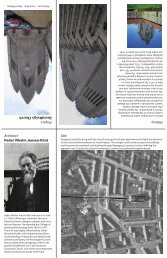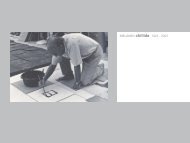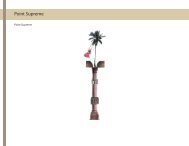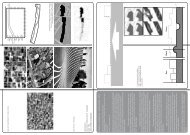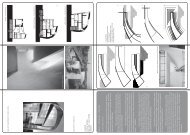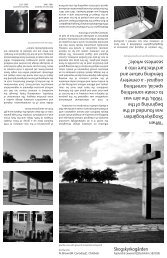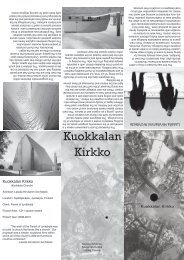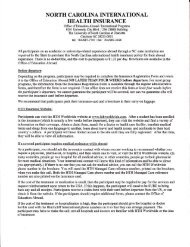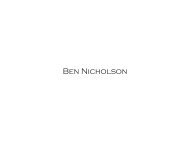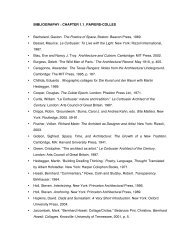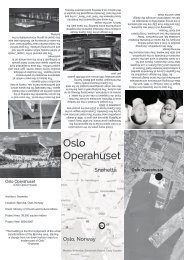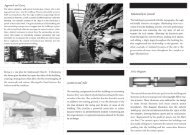Collage Assignment - collage and architecture
Collage Assignment - collage and architecture
Collage Assignment - collage and architecture
You also want an ePaper? Increase the reach of your titles
YUMPU automatically turns print PDFs into web optimized ePapers that Google loves.
ARCHITECTURE AND LANDSCAPE IN SCANDINAVIAINTERPRETATION OF PLACE : PHOTOGRAPHY AND COLLAGEARCH 4050/6050 [J. AND B. SHIELDS]“In architectonic terms, then, Nordic space is topology, Nordic form <strong>collage</strong>, <strong>and</strong> Nordicgestalt a hybrid that unites contradictions.”- Christian Norberg-Schulz, Nightl<strong>and</strong>s: Nordic BuildingPremise.The founders of Cubism valued <strong>collage</strong> as a hybridization of painting <strong>and</strong> sculpture,existing at the threshold of two <strong>and</strong> three dimensions. <strong>Collage</strong> can be used as a tool foranalysis <strong>and</strong> design, a means of diagramming or abstracting three-dimensional space.<strong>Collage</strong> can abstract <strong>and</strong> communicate both formal <strong>and</strong> phenomenal characteristics. Likea <strong>collage</strong>, revealing evidence of time <strong>and</strong> its methods of construction, a work of<strong>architecture</strong> contains this accumulated history. Analysing existing sites <strong>and</strong> buildingsthrough <strong>collage</strong> can capture the givens, the unknowns, <strong>and</strong> the elements in flux.Objective.The objective of this course is to develop skills in analytical <strong>collage</strong>-making. We will focuson two methods: <strong>collage</strong>-drawing <strong>and</strong> photomontage. [Refer to <strong>collage</strong> lecture.] Theseskills will be honed through the daily practice of <strong>collage</strong>, as well as the execution of finalartifacts upon our return to the US. This course offers <strong>collage</strong> as a graphic counterpointto the written analyses conducted in History/Theory.<strong>Collage</strong>-drawing can be defined as a sub-set of <strong>collage</strong> in which select fragments of color,texture, or image are combined with line, exploiting the canvas as a three-dimensional(potentially infinite) space. The plasticity of space plays a primary role in <strong>collage</strong>-drawingcompositions.Photomontage is a composite image consisting of multiple photographic imagesextracted from various sources. The image sources can be divided into two camps: thefound <strong>and</strong> the constructed. Artists <strong>and</strong> architects working in photomontage mayappropriate images from print media, found images, or they may themselves takephotographs for use in their photomontages, constructed images.Your in-situ <strong>collage</strong>-making will employ found images, while your final artifacts may drawfrom both found <strong>and</strong> constructed images.
Method.This course values process work as much as the final product, using in-situ <strong>collage</strong>makingas an iterative practice to improve <strong>and</strong> exp<strong>and</strong> your graphic skills.Process.[1] Continuous <strong>Collage</strong>Your Moleskine Japanese folio will serve as the substrate for a continuous <strong>collage</strong>documenting your experiences through Sc<strong>and</strong>inavia. You will collect paper fragmentsthroughout your travels to use in your <strong>collage</strong>. However, like Richard Meier, the meaninginherent in the image is less important than the color/grain/texture/form. You willpractice with <strong>collage</strong>-drawing <strong>and</strong> photomontage techniques, referencing the artists <strong>and</strong>architects presented prior to our trip. You should use the readings <strong>and</strong> themes asconceptual fodder for your <strong>collage</strong>-making. This practice will likely integrate sketchescreated at various sites with elements of <strong>collage</strong> added later, when you’ve had time toreflect. The transition/translation between <strong>collage</strong> moments will be crucial.[2] <strong>Collage</strong> PostcardsIn each city, you will create one <strong>collage</strong> postcard as a graphic analysis to support yourblog post topic. The 4x6 format will allow you to compose a discreet, containedcomposition, in contrast with the continuous <strong>collage</strong>. Write 1-2 sentences on the back<strong>and</strong> mail to:Bryan <strong>and</strong> Jen Shields1928 Lennox AvenueCharlotte, NC 28203Product.[3] Analytical <strong>Collage</strong> SeriesThe graphic complement to your written precedent analysis will be a series of analytical<strong>collage</strong>s produced upon your return to the US. You will create 3 <strong>collage</strong>s using techniquesof <strong>collage</strong>-drawing <strong>and</strong> photomontage that you’ve developed on the trip. Thephotographic material can be found or constructed, or a combination of the two. Theseries will represent the Pallasmaa theme you chose to use as a lens; each <strong>collage</strong> willrepresent this theme as manifested through one of the vehicles used by the architect.[See history/theory assignment.]These <strong>collage</strong>s must build on your analogue skills, however digital methods of imagemanipulation may be employed. These <strong>collage</strong>s will be produced through mock-up <strong>and</strong>iteration to result in the best possible work for exhibition in the gallery in the fall;dimensional parameters <strong>and</strong> production schedule TBD.



